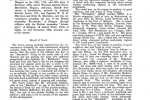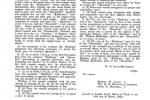The narrow section of the Clyde between the Tail of the Bank and Glasgow has seen hundreds of maritime incidents over the years. These incidents have ranged in severity from vessels straying outwith the channel and stranding, to collisions, often accompanied by serious damage or even total loss of a vessel. One of the most renowned and unfortunate was the collision between the Glasgow cargo steamers Kathleen and Stromboli on New Year’s Eve, 1904.
On the day in question the Kathleen, recently arrived from Bilbao with a cargo of iron ore, had picked up a river pilot at Prince’s Pier, Greenock and proceeded on the final leg of the voyage to Glasgow around 5pm. There was great anticipation among the members of her crew as, being New Year’s Eve, they hoped to reach Glasgow before midnight.
Meanwhile the Stromboli, having left Glasgow earlier in the day for Valencia with a general cargo, was proceeding down river at around five knots. The weather at the time was hazy with visibility around half a mile. As the two vessels approached Garvel Point, a notorious place for mishaps due to the bend in the river, they both reduced their speeds. On starting round Garvel Point those aboard the Kathleen, which was close in to the south side of the channel, observed the Stromboli taking a line inshore of her, effectively cutting the corner. The Stromboli crashed into the Kathleen on her starboard side destroying the aft engine room bulkhead. Water poured into the Kathleen and she began to sink almost immediately. Most of the crew of the Kathleen jumped aboard the Stromboli, as the two vessels were firmly locked together. However, the 1st and 3rd engineers, Andrew McIntosh and James Struthers, were lost as a result of the collision, their escape blocked by the damaged bulkhead.
The ordeal for both crews was not yet over. The Stromboli had also been badly damaged in the collision and, in an attempt to separate his vessel from the Kathleen, the master of the Stromboli, Captain Drummond, ordered ‘engines full astern’ but only succeeded in backing the Stromboli onto the breakwater of James Watt Dock. This was the final blow as the Stromboli too began to fill and settle to the bottom still close by the sunken Kathleen on the south side of the channel. The crews of both vessels then abandoned the Stromboli, their escape aided by the pilot cutter Nathaniel Dunlop and the steamer Cavalier.
Daylight broke on New Year’s Day to reveal both vessels lying half submerged across the channel with most of their superstructures, masts and rigging above water. The Clyde Lighthouse Trust placed a navigation light to the north of the wrecks. However, this did not prevent three vessels colliding with the stern of the Kathleen which protruded furthest into the channel. The most serious of these secondary collisions was that of the SS Ardbeg which stranded and sank on the stern of the Kathleen on 5th January, 1905.
Salvage work began almost immediately, with the removal of the more valuable items of the Stromboli’s cargo which included whisky and sewing machines. After an initial delay caused by a succession of gales, which further damaged both vessels, the first priority of the East Coast Salvage Company was to ‘untoggle’ or separate the wrecks. This task was completed on 18th January and five days later the Stromboli was successfully raised. The work involved in raising the Kathleen was more complex due to the more extensive damage in the collision. However, on 25th February, she too was eventually raised and docked and at last the two bodies of her unfortunate engineers were recovered. The registry of both vessels was closed in following years, first with the Stromboli in 1905 and the Kathleen with a name changed to Beechgrove in 1907.
































